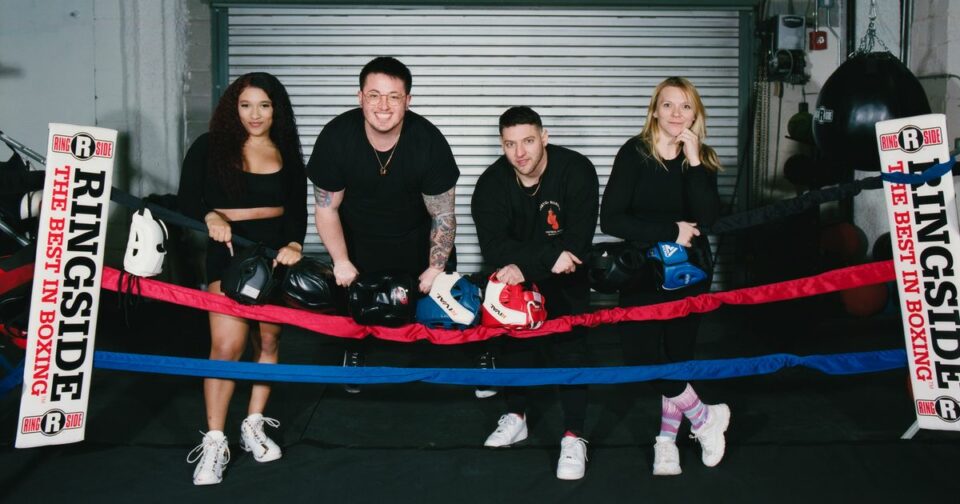On a frigid January afternoon, the staff of the trans-owned and operated OutBox Gym — Max Adler, Colline Laninga, DJ Rock, and Tray Drew — assembled on site in Williamsburg, Brooklyn, with photographer Justin J. Wee. The first half of their shoot was outdoors, against the gym’s entrance in winter’s ephemeral sunlight. Indoor workout attire rarely lends itself to protection against the bitter elements, and the air was so cold it felt like a joke. In between equipment changes, the team wore space blankets; Adler did pull-ups to stay warm.
OutBox, in idea and space, is an antidote, a way to counteract the kinds of division that haunt the fitness world writ large. Weeks before the shoot, USA Boxing, the sport’s highest governing body, released its updated guidelines for trans athletes. In order to compete, trans women over the age of 18 would need to have undergone genital reassignment surgery and submit to quarterly hormone testing for at least four years following. The rules, medievally clinical, refract a much larger paralysis in professional sport over who gets to compete and how. For all the work a human form can do, the lengths it can go to strengthen and heal, there are still institutional regulations on the physical body’s most intimate spaces.
“USA Boxing really does run the professional boxing world,” says Laninga. “It’s a tough thing, to want or need to be certified by them, because there’s a double-edged sword in what comes with that. Trans sport is really not in a good place.”
Today, OutBox has a cushy address and no-frills vibe. The gym is located inside of a converted garage, and the space is set up to ground the work, sweat, and occasional blood that goes into training. Like any good sports underdog story, its origins were humble and ring with the stuff of Netflix documentaries. During the peak doldrums of the pandemic, Adler and Laninga, one-time roommates and eventually neighbors, taught a weekly boxing class outdoors in a public park across the street from their shared apartment building. Gyms were back open, but Adler, who had started medically transitioning a few months into the global shutdown, realized how uncomfortable some of those spaces were. He started an Instagram account to promote a class that would offer strength-building and conditioning access to the trans, gender nonconforming, and LGBTQ+ community. More than 20 people signed up for the first iteration that spring, so he asked for Laninga’s help to run it.


The need for a dedicated space arose quickly. “We shared that park with just about everyone and everything you could imagine,” says Laninga. “Kids, drum lines. They were right there with us.” Children occasionally ran past to try and grab their gloves during lessons. Classes got rained out. Cooler fall temperatures loomed. Somehow, the gym’s existence accelerated faster than the desire that preceded it. One of Adler’s friends sent him a listing for a space that had been sitting empty for over a year and that had once been used as a martial-arts gym.
“Everything happened so fast,” says Adler. “One second we were in the park, and the next the broker was hounding me to put in an offer. I didn’t even have a lawyer to review the lease. I didn’t know what I was doing.” OutBox Gym opened its doors in the fall of 2021. “When you look back,” he says, “it’s crazy. We didn’t have mats. We didn’t have the ring. It was just an empty garage. We sold out our opening night.”
At one point during the shoot, the team posed together in one of the gym’s genderless bathrooms. The space was a little tight for four. “We’ll wipe the seat down first; this is a gym,” someone quipped. Snickering followed. In the background, clients began to trickle in and warm up for class.
A few weeks later, I ask Laninga what she wishes more people knew — about OutBox specifically but also about the community she and Adler have built there.
“Anybody thinking of coming, anybody who’s nervous or not sure or they don’t know if they’re gonna be good enough — anybody feeling that way can just show up,“ she says. “Because that is the hardest part: to just show up. We tell everyone at the beginning of every class to do whatever you want, you know? You choose what you want to do, and you don’t do what you don’t want to do, and it’s all okay in our space. It’s all okay.” There are no delineations on the weights, or in the restrooms, for men and women. If two people are paired up together during a group class, it’s because they’re similar heights. “It isn’t hard to take gender out of the experience,” Laninga adds. “It isn’t hard to let there be a place where people can work out and learn a sport and have joy in their exercise. The barrier to creating something like this, something for everyone, isn’t as hard as I think it’s made out to be.”
Production Credits
Photography by Justin J Wee
,
Photo Assistant Marion Aguas
,
The Cut, Editor-in-Chief Lindsay Peoples
,
The Cut, Photo Director Noelle Lacombe
,
The Cut, Photo Editor Maridelis Morales Rosado
,
The Cut, Deputy Culture Editor Brooke Marine
Related
- The Girls Shredding the Bronx
Caira Conner , 2024-02-28 17:00:51
Source link


